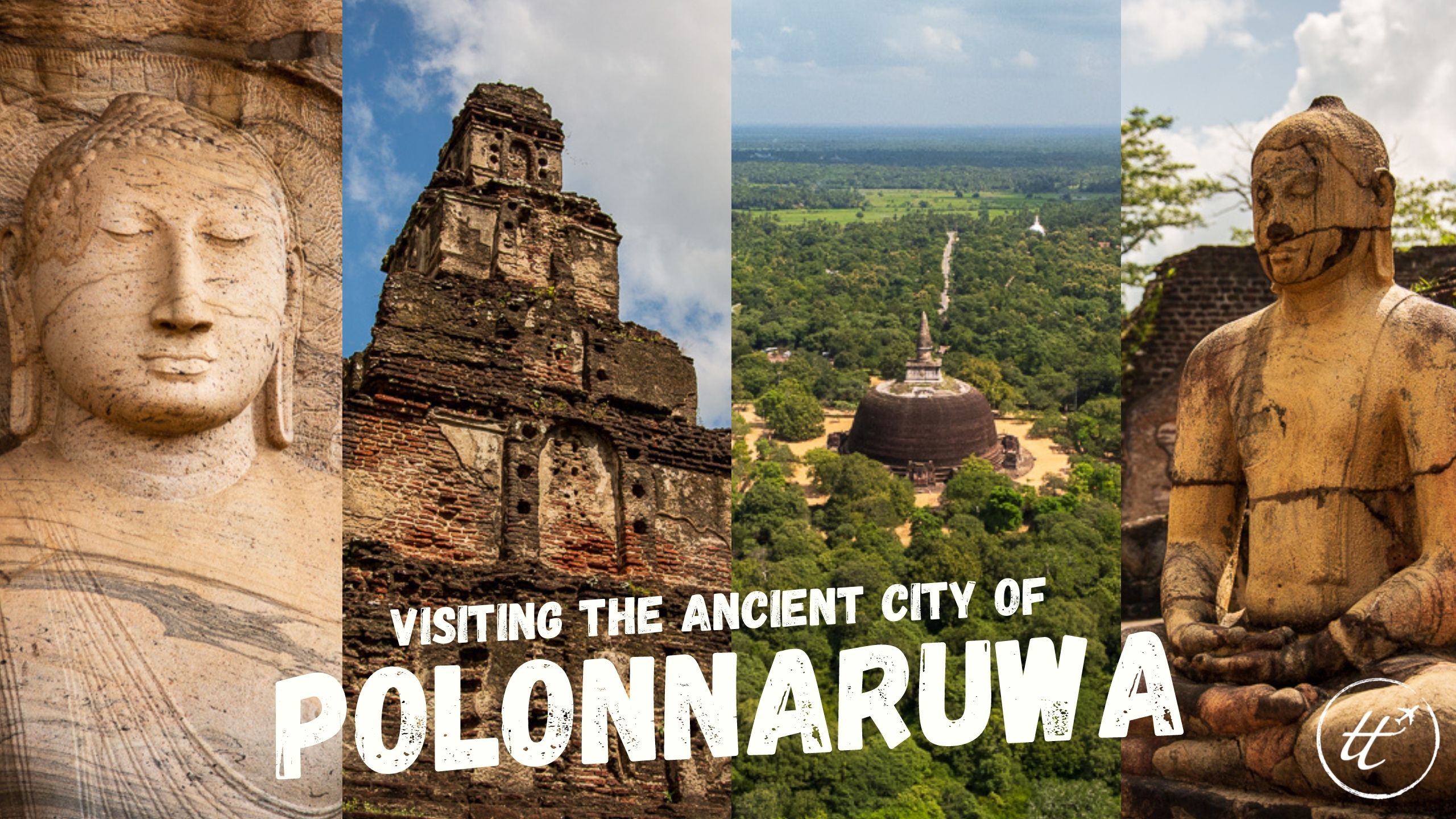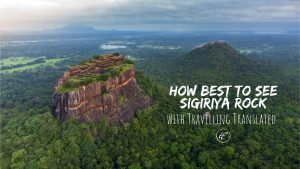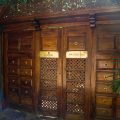Polonnaruwa is a haven to religious sites, ruins and relics that date back to before 1070AD. The Ancient City of Polonnaruwa is Sri Lanka’s second largest kingdom and has been declared a World Heritage Site by UNESCO. Polonnaruwa remains one of the best planned Archaeological relic sites in the country and a must visit when travelling in Sri Lanka.
Before you set off on your day exploring the Ancient City of Polonnaruwa you need to visit the ticket office. Here, you will be able to pay a tour guide to join you on your exploration and talk you through more historical notes on each ruin. Recommended if you’re a history buff!
You will be able to visit the Archaeological Museum immediately after buying your admission ticket. This is where you will be able to see scale models of the temples and buildings across the city, reimagining what they looked like in their glory days. We would have loved to have taken photographs but all type of photography was prohibited in this museum. There is no need to spend long in here as the magic is at the ruins themselves.
Now let’s stop waffling and get down to business! Our top sites and ruins in Polonnaruwa. For your ease we will label them in the order that we visited in the tuk tuk! If you’re on a tour you will normally see all of the below.
1) King Nissankamalla (1187 – 1196) Palace Complex
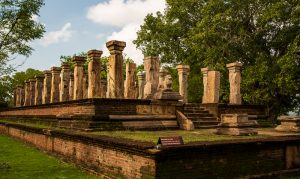
This complex acts as a nice introduction to the day as it is literally a 1 minute tuk tuk ride from the ticket office. The only thing that remains is the audience hall. The building is guarded by two stone carved lions and even the throne itself is a granite lion. The palace no longer stands and only the outer stone walls remain. When we visited it seemed the only residences were the cows that had has taken over the ruins.
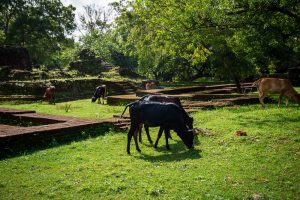
King Parakramabahu I (1153 -86) – Royal Palace Group (2, 3 & 4)
It is worth noting that the next three listed (2, 3 & 4) are within the same area and are very short walking distance of each other. This is where we also enjoyed a refreshing ice cream!
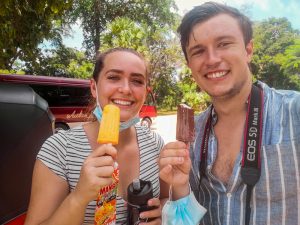
2) The Polonnaruwa Royal Palace
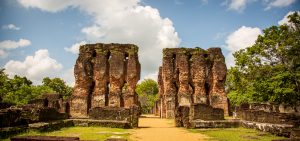
The Royal Palace was once the grand residence of King Parakramabahu (1153-1186). Archaeologists claim it was once seven floors tall with 50 rooms! The palace ruins are still very impressive but today only some of the walls remain. We do wonder how buildings like this were made over 800 years ago.
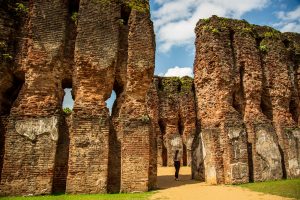
3) Council Chamber
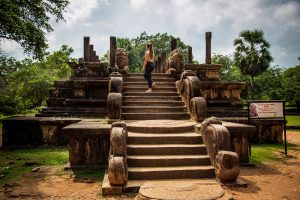
This is the Council Chamber/Audience Hall of King Parakramabahu I (1153 -86). The Council Chamber would have been used by the King to hear petitions from the nobles of the kingdom and representatives of foreign countries.
4) Swimming Pool/Bathing Pool
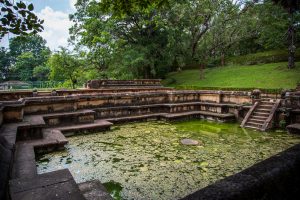
Truthfully we’d suggest to skip this if it wasn’t in the same complex of buildings. Maybe that’s just us being a little negative. These are the remains of the King’s bathing pools. Today the water is not very inviting with a slight funky smell and fluorescent shades of green.
The Quadrangle Complex (5, 6, 7 & 8)
The Sacred Quadrangle was our favourite spot in the Ancient City. There are a number of historically significant monuments built on this site including our listed 5, 6, 7 & 8. It’s the most concentrated collection of buildings you’ll find in the Ancient Cities. Most of the monuments were constructed for the purpose of storing the Tooth Relic. What is this tooth relic we speak of? Well, according to Sri Lankan legends, when the Buddha passed away in 543 BC, his body was cremated. His left canine tooth was retrieved from the funeral pyre by his disciple, Khema and is now an ancient and sacred relic. Today, the tooth relic is housed in Kandy.
5) Vatadage
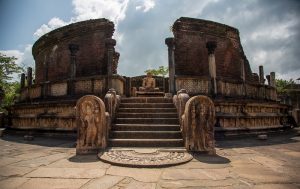
Our favourite temple in the Quadrangle. It is a Buddhist building and home to four Buddha statues (some now damaged) surrounding the dagaba (a dome-shaped shrine containing relics of the Buddha or a Buddhist saint). The Vatadage would have been covered by a dome which has collapsed over time. It was almost certainly intended to house the sacred Tooth Relic. The outermost terrace is an impressive 18 metres in diameter. A 12th Century masterpiece!
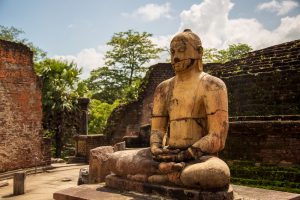
6) Atadage
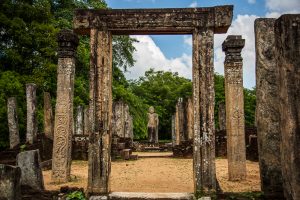
Constructed in the 11th Century, this was the first Tooth Temple. The 54 stone columns, some beautifully carved, would have supported a timber upper floor in which the Tooth Relic was kept. It is the only surviving structure dating back to this period in this area.
7) Hatadage
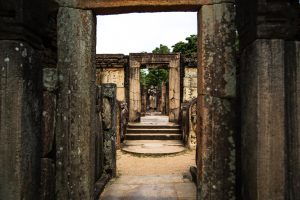 Directly opposite the main entrance point to the Vatadage you will find the Hatadage. This is a relic house resembling the Atadage in design and purpose to house and protect the Tooth Relic.
Directly opposite the main entrance point to the Vatadage you will find the Hatadage. This is a relic house resembling the Atadage in design and purpose to house and protect the Tooth Relic.
8) Sathmahal Pasada
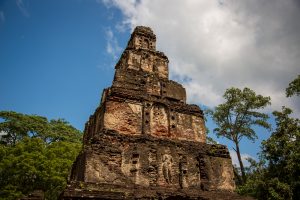
The style of the tower is very unusual and complicated and is therefore believed to be influenced by oriental architecture. It was once 7 floors high but only 6 can be seen today. The tallest building in the area towering above all other sacred sites in the Quadrangle.
9) Shiva Devale No.2
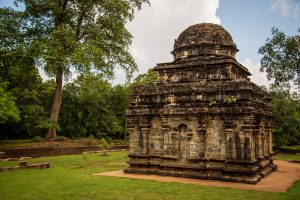
This is the oldest structure in Polonnaruwa! It dates back to when the Indian invaders took over and established the city. The Shiva Devale No.2 is the oldest Hindu shrine in Polonnaruwa and extremely well preserved as it’s made entirely out of stone. Side note – we saw absolutely tons of monkeys here harassing tourists setting up for a picnic. We couldn’t help but have a little giggle. If you go early enough you can get a good deal on a pamper session from the local residents.

10) Rankot Vihara
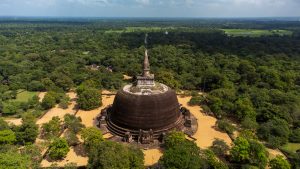
Rankot Vehera was another one of our favourites. Built entirely from brick the dagaba is the largest in Polonnaruwa and the fourth largest in Sri Lanka. Amazing to think it opened in 1190.
Little tip – bring socks with you. You have to remove your footwear at the base of this dome and the sand gets very hot! We must have looked like such idiots.
11) Lankatilaka Vihara
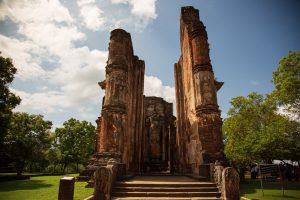
This sacred shrine stands impressively tall with 17 metre high walls. You get this feeling of being in a cathedral when walking into this ruin, even with the roof gone. At the far end you will be greeted by a grand standing Buddha statue without a head. We particularly enjoyed the aesthetic of the side entrance. Looks like a scene out of Tomb Raider!
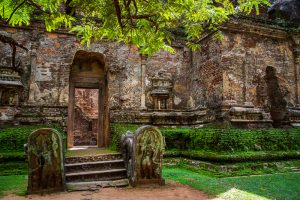
12) Dagaba Kiri Vihara
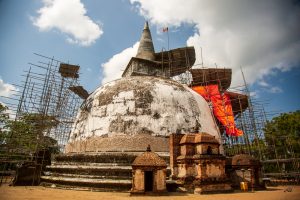
Whilst we were here there was some interesting looking construction works going on… We’re not sure who was in charge of scaffolding but not sure we’d trust that! It is said to be the best preserved and unrestored dagaba in Polonnaruwa surviving 900 years of nature. The Dagaba Kiri Vahara was built in honour of the King’s Queen. Also, we loved this sign!!
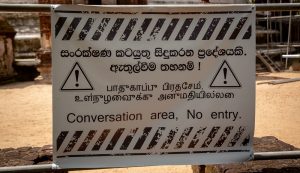
13) Gal Vihara
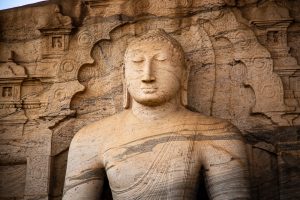
Gal Vihara translated as ‘rock monastery’ displays four remarkable Buddhas cut out of the enormous slab of granite. They are in perfect condition! How this was fashioned in the 12th Century we will never know! The reclining Buddha is over 14 metres in length!
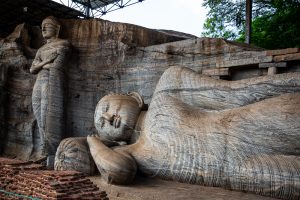
If you have time you could contemplate visiting the North or South part of the Ancient City for the ultimate full experience!
Northern Part of the City
14) Thivanka Image House
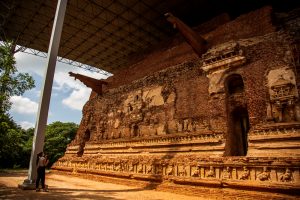
At this point in our day we were tired and nearly skipped the Thivanka Image House. Inside the Image House are murals that are considered to be cultural treasures. It’s worth mentioning that photography is prohibited inside and the building is pretty damaged. Even so, details found were pretty remarkable.
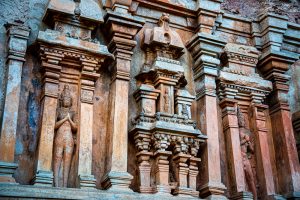
15) Lotus Pond
After 6 hours of baking in the sun, seeing The Lotus Pond was no longer a priority, a shower was. In hindsight it would have been great to finish our day here but never mind! It is believed to be the bath provided by the King for the monks belonging to the Jetavana Vihara (one of the most famous Buddhist monasteries).
Southern Part of the City
16) Pothgul Viharaya
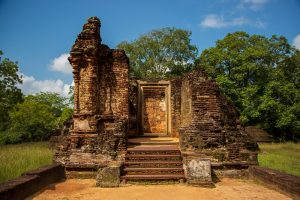 If you have more time we suggest going South outside the ‘walls’ of the sacred city to see Pothgul Viharaya. It is thought to be a Buddhist library complex and a place where Buddhist writings were studied. Again this site was considered to be built by King Parakramabahu I (1153 -86). This was one of the first places we visited with our driver. Probably not realistic if you’re travelling by bicycle!
If you have more time we suggest going South outside the ‘walls’ of the sacred city to see Pothgul Viharaya. It is thought to be a Buddhist library complex and a place where Buddhist writings were studied. Again this site was considered to be built by King Parakramabahu I (1153 -86). This was one of the first places we visited with our driver. Probably not realistic if you’re travelling by bicycle!
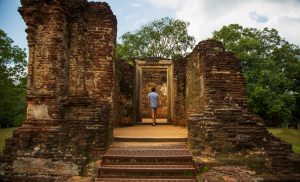
After you’ve completed your day exploring Polonnaruwa you might be thinking of where to visit next? Sigiriya is the perfect next stop! Only around an hour away you could prepare to hike Pidurangala Rock and view Sigiriya Rock emerging from the jungles below. Find out more with us here!

